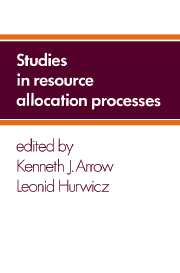Book contents
- Frontmatter
- Contents
- Preface
- Acknowledgments for reprinted articles
- PART I General introduction
- PART II Economies with a single maximand
- 1 General survey
- 2 Static characterization
- 3 Decentralization within firms
- 4 Dynamic characterization
- 5 The handling of nonconvexities
- PART III Economies with multiple objectives
- PART IV General characterizations of allocation processes
- Appendix: An optimality criterion for decision-making under ignorance
- Author index
- Subject index
- Index of examples
4 - Dynamic characterization
Published online by Cambridge University Press: 04 April 2011
- Frontmatter
- Contents
- Preface
- Acknowledgments for reprinted articles
- PART I General introduction
- PART II Economies with a single maximand
- 1 General survey
- 2 Static characterization
- 3 Decentralization within firms
- 4 Dynamic characterization
- 5 The handling of nonconvexities
- PART III Economies with multiple objectives
- PART IV General characterizations of allocation processes
- Appendix: An optimality criterion for decision-making under ignorance
- Author index
- Subject index
- Index of examples
Summary
This paper deals with the application of certain computational methods to evaluate constrained extrema, maxima, or minima. To introduce the subject, we will first discuss nonlinear games. Under certain conditions, the finding of the minimax of a certain expression is closely related to, in fact identical with, the finding of a constrained minimum or maximum. Let us consider then a game (in a generalized sense) where player 1 has the choice of a certain set of numbers x1, …, xm that are constrained to be nonnegative for present purposes and player 2 selects numbers y1, …, yn also constrained to be nonnegative but otherwise unrestricted. The payoff of the game, the payment made by player 2 to player 1, will be a function of the decisions made by the two players, the x's and the y's. This pay off will be designated by φ(x1, …, xm; y1, …, yx, …, yn). To play the game in an ideal way is to find the minimax solution; we know this solution exists under certain conditions. That is, we arrive at a choice of strategies by the two players where player 1 is maximizing his payoff given the strategy of player 2, and player 2 is minimizing the payoff, given the strategy of player 1.
- Type
- Chapter
- Information
- Studies in Resource Allocation Processes , pp. 146 - 153Publisher: Cambridge University PressPrint publication year: 1977
- 5
- Cited by



